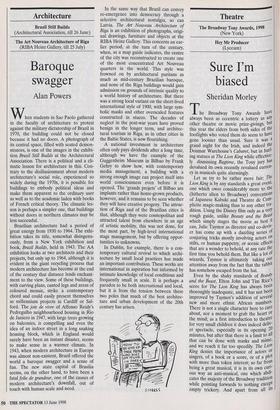Architecture
Brazil Still Builds (Architectural Association, till 26 June)
Baroque swagger
Alan Powers When students in Sao Paolo gathered in the faculty of architecture to protest against the military dictatorship of Brazil in 1970, the building could not be closed because it had no doors. A photograph of its central space, filled with seated demon- strators, is one of the images in the exhibi- tion Brazil Still Builds at the Architectural Association. There is a political and a cli- matic lesson for architecture in this. Con- trary to the disillusionment about modern architecture's social role, experienced so widely during the 1970s, it is possible for buildings to embody political ideas and make them apparent to the ordinary user as well as to the academic laden with books of French critical theory. The climatic les- son is perhaps a simpler one, that buildings without doors in northern climates may be less successful.
Brazilian architecture had a period of 'great energy from 1930 to 1964. The exhi- bition takes its title, somewhat disingenu- ously, from a New York exhibition and book, Brazil Builds, held in 1943. The AA exhibition looks at two architects and their projects, but only up to 1964, although it is evident in the giant recycling process that modern architecture has become at the end of the century that distance lends enchant- ment to the view. Some of these buildings, with curving plans, canted legs and areas of coloured mosaic, strike a contemporary chord and could easily present themselves as millennium projects in Cardiff or Sal- ford. The joie de vivre of Affonso Reidy's Pedregulho neighbourhood housing in Rio de Janiero in 1947, with large trees growing on balconies, is compelling and even the idea of an indoor street in a long snaking housing block, which in England would surely have been an instant disaster, seems to make sense in a warmer climate. In 1943, when modern architecture in Europe was almost non-existent, Brazil offered the world a baroque swagger and a sense of fun. The new state capital of Brasilia seems, on the other hand, to have been a fatal folie de grandeur, one of the causes of modern architecture's downfall, out of touch with human scale and need. In the same way that Brazil can convey re-emergence into democracy through a selective architectural nostalgia, so can Latvia. The Art Nouveau Architecture of Riga is an exhibition of photographs, origi- nal drawings, furniture and objects at the RIBA Heinz Gallery. This concerns an ear- lier period, at the turn of the century, when, as a map guide indicates, the centre of the city was reconstructed to create one of the most concentrated Art Nouveau quarters in the world. This style was frowned on by architectural puritans as much as mid-century Brazilian baroque, and none of the Riga buildings would gain admission on grounds of intrinsic quality to a world history of architecture. But there was a strong local variant on the short-lived international style of 1900, with large sym- bolic masks and other overscaled features constructed in stucco. The decades of neglect in the post-war years have proved benign in the longer term, and architec- tural tourism in Riga, as in other cities in the Baltic States, is now flourishing. A national investment in architecture often only pays dividends after a long time, although we have the example of the Guggenheim Museum in Bilbao by Frank Gehry to show how, with contemporary media management, a building with a strong enough image can project itself into world consciousness even before it is opened. The `grands projets' of Bilbao are implants rather than home-grown products, however, and it remains to be seen whether they will have creative progeny. The attrac- tion of Riga and of the Brazilian cities is that, although they were cosmopolitan and attracted talent from elsewhere in an age of artistic mobility, this was not done, for the most part, by high-level international stage management, but by offering oppor- tunities to unknowns.
In Dublin, for example, there is a con- temporary cultural revival to which archi- tecture by small local practices has made an important contribution. These works are international in aspiration but informed by intimate knowledge of local conditions and frequently small in scale. It is perhaps . a paradox to be both international and local, but it is from the tension between these two poles that much of the best architec- ture and urban development of the 20th century has arisen.


































































 Previous page
Previous page